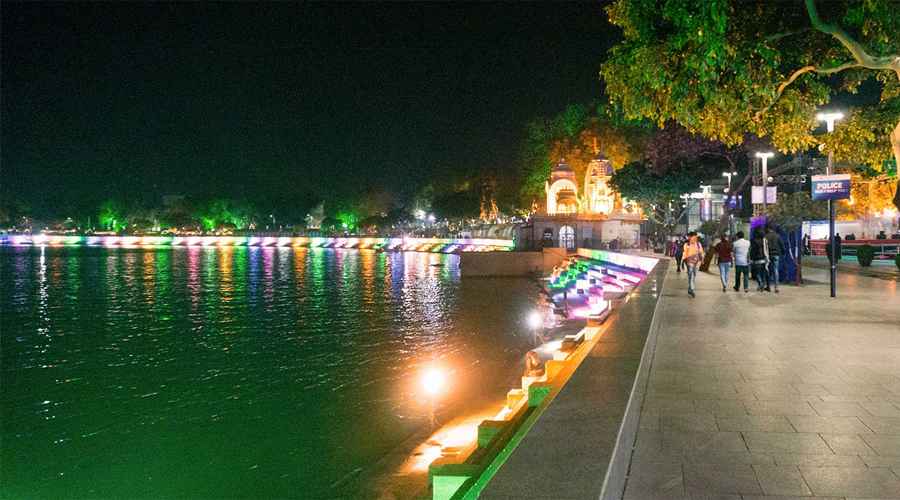Kankaria Lake, located in the bustling city of Ahmedabad in Gujarat, is one of the most iconic landmarks of western India. Known for its scenic beauty, rich history, and recreational activities, the lake stands as a beloved urban attraction. Its charm lies both in its centuries-old heritage and its transformation into a modern leisure hub. For residents of Ahmedabad, Kankaria is not just a water body but a space where people gather, celebrate festivals, enjoy rides, and explore traditions. For visitors, it offers a vibrant glimpse into the life and culture of the city.
Historical Background
Kankaria Lake was constructed in the 15th century during the reign of Sultan Qutb-ud-Din Ahmad Shah II. Initially called “Hauz-e-Qutb,” it was designed as a water reservoir to supply drinking water to the city. Circular in shape, with stone steps leading down to the water, its layout is a masterpiece of medieval engineering. At the center of the lake lies the Nagina Wadi, a charming island garden connected by a bridge. The lake reflects the fusion of utility and artistry that rulers of Gujarat emphasized in their public projects.
Over the centuries, Kankaria has transitioned from being a royal retreat to a public playground. In recent decades, upgrading and redevelopment by local authorities have enhanced it with amusement facilities, maintaining its old charm while meeting the demands of a modern city.
Natural Beauty and Atmosphere
With a circumference of about 2.25 kilometers, Kankaria Lake is a vast and open space amid the otherwise crowded city. Especially in the mornings and evenings, it becomes a haven for joggers, walkers, and families. The lake’s blue-green waters playfully reflect the sunlight during the day, while at night, colorful lights illuminate the surroundings. Nagina Wadi, decorated with fountains and gardens, adds to the serenity of the space.
The atmosphere around the lake beautifully combines calmness with liveliness. Visitors can sit peacefully by the steps and observe the waters or indulge themselves in adventure activities. This dual identity makes it suitable for both relaxation and celebration.
Attractions Around Kankaria
The lake today serves as a vibrant urban entertainment zone. Several attractions have turned the area into a day-long destination for tourists and locals alike.
- Kankaria Zoo (Kamla Nehru Zoological Garden): Spread across 117 acres, it is home to mammals, birds, and reptiles, attracting families and children.
- Balvatika and Amusement Park: A children’s park with rides, toy trains, and swings, appealing strongly to younger age groups.
- Kankaria Adventure Park: Offers thrilling rides, zip lines, and other adventure activities for those seeking excitement.
- Toy Train Ride: A mini train circles the lake, giving a complete view of the water and its surroundings in a leisurely, fun-filled manner.
- Balloon Ride: The tethered helium balloon, rising up to 350 feet, provides an aerial view of Ahmedabad.
- Nagina Wadi: The garden island at the heart of the lake, with colorful fountains and musical shows in the evenings.
Additionally, the pedestrian pathway around the lake makes walking and cycling enjoyable, offering both fitness and leisure opportunities. Street food stalls serving delicious Gujarati snacks like khaman, dhokla, and kulfi add to the cultural flavor.
Festivals and Events
One of the major highlights of Kankaria is the annual Kankaria Carnival, usually held in December. This week-long celebration turns the lake into a grand stage for cultural performances, music shows, dance, art displays, and fireworks. Thousands of people attend, making it one of the largest public festivals in Ahmedabad. Beyond the carnival, events like yoga sessions, morning music programs, and patriotic celebrations on Independence Day also showcase its role as a community hub.
Cultural and Social Significance
For Amdavadis, Kankaria Lake is more than just an attraction—it is a part of their daily lives and memories. Whether it is morning exercise for the elderly, weekend outings for families, or a romantic stroll for young couples, the lake caters to all. Its centrality to Ahmedabad’s cultural space also lies in its accessibility. People from every background gather here, creating a diverse crowd. In many ways, Kankaria becomes a melting pot where urban India’s spirit is reflected.
Moreover, Kankaria represents how historic monuments can be given new life through thoughtful development. The preservation of its stone architecture alongside modern amusements ensures that history and contemporary leisure coexist harmoniously. It also showcases the progressive urban planning of Ahmedabad, which has always placed importance on green spaces and public recreation.
Best Time to Visit Kankaria Lake
Though Kankaria can be visited throughout the year, the winter months between November and February are ideal. The cool weather enhances the experience of outdoor activities. Evenings, when the lakefront is illuminated, create an enchanting ambiance. Mornings are quieter, making them suitable for nature walks, birdwatching, or spending solitary time by the water.
Tips for Visitors
- Plan for at least half a day to enjoy the zoo, toy train, rides, and Nagina Wadi.
- Arrive in the evening to catch the musical fountain and nighttime lighting.
- Try local food stalls for an authentic Ahmedabad flavor.
- Visit during the Kankaria Carnival to witness the lake’s most festive avatar.
- Prefer weekdays to avoid heavy crowds, particularly on weekends.
Connecting Past and Present
Kankaria Lake’s timeless appeal lies in its ability to adapt without losing its heritage essence. What was once a water reservoir during the reign of Gujarat’s sultans is now an emblem of Ahmedabad’s cultural pride. It mirrors the city’s broader identity: a city that carries centuries of history but also embraces modernity with joy and color.
For travelers exploring Gujarat, a visit to Kankaria Lake is indispensable. It offers an engaging combination of amusement, heritage, and local life. For residents, it remains a cherished slice of daily routine and a reminder of their city’s collective spirit.


